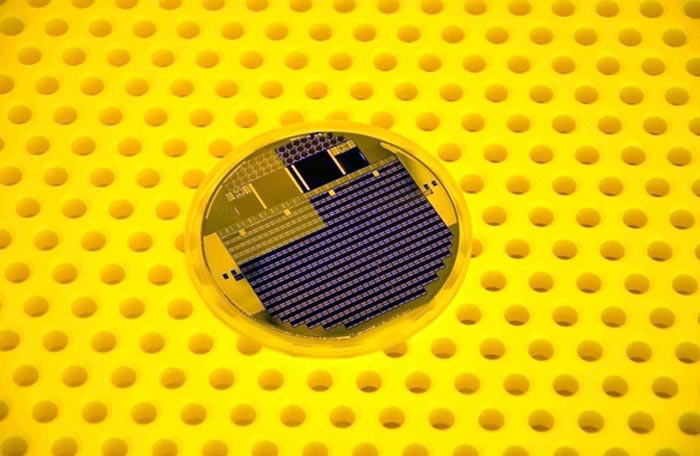Fraunhofer ISE Develops the World’s Most Efficient Solar Cell with 47.6 Percent Efficiency

Thanks to improved antireflection layers, the efficiency of the best four-junction solar cell to date improved from 46.1 to 47.6 percent.
© Fraunhofer ISE
Researchers at the Fraunhofer Institute for Solar Energy Systems ISE, using a new antireflection coating, have successfully increased the efficiency of the best four-junction solar cell to date from 46.1 to 47.6 percent at a concentration of 665 suns. This is a global milestone, as there is currently no solar cell with a higher efficiency worldwide. The results are presented today at the 2nd International tandemPV Workshop, taking place in Freiburg, Germany.
For the last two years, Fraunhofer ISE has been working on an ambitious project called “50 Percent.” The aim of the project, which is funded by the German Federal Ministry for Economic Affairs and Climate Action BMWK, is to develop a solar cell with 50 per-cent efficiency for the first time. To achieve this, each individual layer of the complex multi-junction solar cell undergoes further optimization. Improvements in the process technology are incorporated for metal contacts and antireflection layers. Now the project team has achieved a first breakthrough: Their latest solar cell under concentrated sunlight achieves an efficiency of 47.6 percent.
“We are thrilled with this result, which was achieved only one year after the opening of our new Center for High Efficiency Solar Cells,” says Dr. Frank Dimroth, department head of III-V Photovoltaics and Concentrator Technology at Fraunhofer ISE. “In our research, we aim to make concentrating photovoltaics even more efficient and competitive, as we believe that this is the most sustainable form of renewable electricity generation.”
The layer structure of the new solar cell was developed back in 2016 together with the French company Soitec Inc., that designs and manufactures innovative semiconductor materials. The upper tandem solar cell is made of gallium indium phosphide (GaInP) and aluminum gallium arsenide (AlGaAs), which was bonded by Soitec onto a lower tandem solar cell made of gallium indium arsenide phosphide (GaInAsP) and gallium indium arsenide (GaInAs).
Now an improved contact layer and a 4-layer antireflection coating were applied to the tandem cell structure in Fraunhofer ISE’s Center for High Efficiency Solar Cells. These measures reduce the resistance losses and the reflection on the front side of the cell, which is spectrally sensitive within a broad range of 300 and 1780 nanometers. Con-ventional solar cells made of silicon absorb sunlight only up to a wavelength of 1200 nanometers and thus do not require such a broadband antireflection coating.
Multi-junction solar cells made of III-V compound semiconductors have always been among the most efficient solar cells in the world. They reach their highest potential when the incoming sunlight is concentrated by lenses onto miniature solar cell devices of just a few square millimeters in size. “Possible applications of such highly efficient tandem solar cells include concentrator photovoltaic systems, which contribute to efficient power generation in sun-rich countries,” says Prof. Dr. Stefan Glunz, division director of Photovoltaics Research at Fraunhofer ISE. “With tandem photovoltaics, it is possible to leave the limitations of single-junction solar cells behind and ultimately achieve a reduction in solar power costs.”
Weitere Informationen:
https://www.ise.fraunhofer.de/en/press-media/press-releases/2022/fraunhofer-ise-…
Media Contact
All latest news from the category: Power and Electrical Engineering
This topic covers issues related to energy generation, conversion, transportation and consumption and how the industry is addressing the challenge of energy efficiency in general.
innovations-report provides in-depth and informative reports and articles on subjects ranging from wind energy, fuel cell technology, solar energy, geothermal energy, petroleum, gas, nuclear engineering, alternative energy and energy efficiency to fusion, hydrogen and superconductor technologies.
Newest articles

Innovative 3D printed scaffolds offer new hope for bone healing
Researchers at the Institute for Bioengineering of Catalonia have developed novel 3D printed PLA-CaP scaffolds that promote blood vessel formation, ensuring better healing and regeneration of bone tissue. Bone is…

The surprising role of gut infection in Alzheimer’s disease
ASU- and Banner Alzheimer’s Institute-led study implicates link between a common virus and the disease, which travels from the gut to the brain and may be a target for antiviral…

Molecular gardening: New enzymes discovered for protein modification pruning
How deubiquitinases USP53 and USP54 cleave long polyubiquitin chains and how the former is linked to liver disease in children. Deubiquitinases (DUBs) are enzymes used by cells to trim protein…



